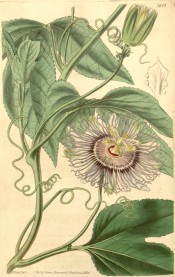Passiflora edulis Sims var. incarnata
Passiflora incarnata of Linnaeus is now recognised as a form of Passiflora edulis Sims. Half-hardy vine with trilobed leaves, to 15cm, and pale lavender flowers, to 7.5cm across, with pink to purple filaments, followed by yellow fruit to 5cm across. [RHSD, Hortus].
Horticultural & Botanical History
‘This is the first species of the genus which was introduced to Europe, and has suggested the generic name. The plant was originally discovered by the Spaniards, who called it, like the other forms of Granadilla, from a resemblance they conceived the fruit to bear of the common Pomegranate. But on its appearance in Italy, which seems to have occurred in the commencement of the 17th century, superstition decried in the configuration of the different parts a mysterious representation of the Passion of Christ, and the priests strove to turn the new vegetable prodigy to account. The leaf, as is well known, was expounded to be the spear which pierced the side, the twined threads of red and white which form the crown of the flower the lashes of the whip tinged with blood, the five encircling stamens the crown of thorns, the column in the centre of the flower a miniature of that, which served in the flagellation, the three clavate stigmas the three nails used in the crucifixion’ [BR f.152/1816].
‘The present is the North American plant included by Linnaeus in his Passiflora incarnata; but if it is to be held a distinct species from that which we have given as the variety beta in the 152d article of this work, not the one by which the genus first made its appearance in Europe; although both have been combined under the Linnean incarnata. The species which first appeared in Europe, we have little doubt, was that which we have given in the above cited article, and which has since been published in Curtis’s Magazine and in the Horticultural Transactions, by the specific title of edulis. Some botanists however are of a different opinion, and think the original plant was neither the present species, nor that we speak of, but a different, though closely allied, one.’ [BR f. 332/1818]. BM t.3697/1838.
History at Camden Park
Listed in all published catalogues [T.729/1843].
Notes
Published Jan 31, 2010 - 02:06 PM | Last updated Jul 29, 2010 - 02:05 PM
| Family | Passifloraceae |
|---|---|
| Category | |
| Region of origin | South eastern North America |
| Synonyms |
|
| Common Name | Apricot vine, May Pops, May Apple |
| Name in the Camden Park Record |
Passiflora incarnata |
| Confidence level | high |


